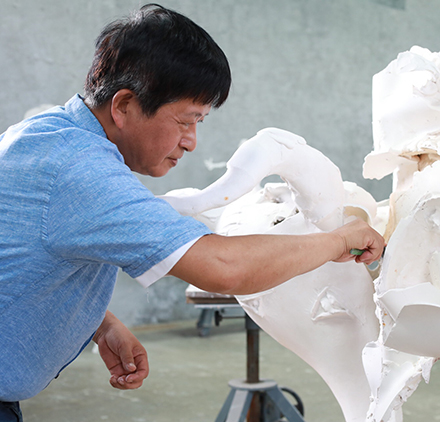
 Born in Kaohsiung, Taiwan in 1954, Lee Kuang-Yu completed his formal sculptural training at the National Taiwan Academy of Arts (now the National Taiwan University of Arts) in the mid-1970s. He then pursued further studies in Spain at the Royal Academy of Fine Arts of San Fernando (Real Academia de Bellas Artes de San Fernando) and the Complutense University of Madrid (Universidad Complutense de Madrid, UCM), where he studied under renowned sculptor Francisco Toledo, eventually earning a master's degree. Upon returning to Taiwan, he taught at the National Taipei University of the Arts and the National Taiwan University of Arts until his retirement in 2006. He currently lives and creates in Taipei, Taiwan.
Born in Kaohsiung, Taiwan in 1954, Lee Kuang-Yu completed his formal sculptural training at the National Taiwan Academy of Arts (now the National Taiwan University of Arts) in the mid-1970s. He then pursued further studies in Spain at the Royal Academy of Fine Arts of San Fernando (Real Academia de Bellas Artes de San Fernando) and the Complutense University of Madrid (Universidad Complutense de Madrid, UCM), where he studied under renowned sculptor Francisco Toledo, eventually earning a master's degree. Upon returning to Taiwan, he taught at the National Taipei University of the Arts and the National Taiwan University of Arts until his retirement in 2006. He currently lives and creates in Taipei, Taiwan.
In the development of Taiwanese sculpture, Lee's work transcends cultural and historical dimensions, becoming a cultural reference point where Eastern tradition and Western modernism intersect. His work embodies a profound local culture heritage while also integrating diverse international influences, resulting in a unique sculptural aesthetic. Since the 1980s, Lee has continued to explore the spatial characteristics inherent in sculpture, employing techniques such as "piercing" to break the closed structure of sculpture. This has led him to develop a form of expression based on the concept of "emptiness" that differs from Western traditions, meanwhile presenting the "silent void in the Oriental culture". Through the contrast of unreality and reality, emptiness and fullness, Lee creates emotionally charged virtual spaces that reflect a thoughtful exploration of the present life and deep philosophical contemplation.
Some of his early landmark exhibitions include the 1981 Fall Salón in Spain, the 3rd Asian Art Exhibition at the Fukuoka National Museum of Modern Art in Japan in 1988, the 1995 Austria Graz International Sculpture Craft Workshop Exhibition in Graz, Austria, the 1999 Volume & Form International Sculpture Exhibition in Singapore, his solo exhibition Life, Illusion of Bodies at the National Taiwan Museum of Fine Arts in 2011, and the 2014–2015 A Symphonic Concoction: Sculpting Art in Taiwan in the 1980s at the Juming Museum in Taipei.
In 2015, Lee was invited to participate in the OPEN 18. International Exhibition of Sculptures and Installations in Venice. The exhibition gathered works by many renowned artists, including Italian artist Michelangelo Pistoletto and South Korean artist Nam June Paik. In the same year, three of Lee's works—Empty Procession, Subduing, and Thinker—were also selected for the important group exhibition The Moment–The Taiwanese Art Project in New York, further solidifying his position in the international art scene.
In 2017, Lee was invited to have a major solo exhibition To Have and Have Not at the San Marino Pavilion at the Venice Biennale. The exhibition focused on his thirty years of sculptural creations and artistic achievements, showcasing his distinctive exploration of sculptural aesthetics. Moreover, the title "To Have and Have Not" pays tribute to the history of the exhibition venue, which was once frequented by American author Ernest Hemingway in the late 1940s and early 1950s. The title ("To Have and Have Not"), borrowed from Hemingway's novel of the same name, resonates with the artist’s meditation on the uncertain state of the modern world, while also offering a humanistic reflection on contemporary society.
In 2018, the Kaohsiung Museum of Fine Arts held the Space, Poetry, and People: A Retrospective of LEE Kuang-Yu's Work, showcasing 50 key pieces from his career spanning from 1986 to 2017. The theme "Space, Poetry, and People" reflects his sculptural language, which derives from his poetic and emotional life. In conjunction with the exhibition, the Contemporary Art Foundation hosted an international academic symposium "The Poetics of Space: International Conference on LEE Kuang-Yu's Art of Sculpture" with Dr. YANG Shin-Yi, curator of Lee's 2017 Venice Biennale exhibition, was invited as the academic host. Nine scholars from prestigious institutions were also invited to engage in deep discussions on Lee's sculptural language, its philosophical significance, and its relevance to contemporary society.
In 2020, Lee had a large-scale outdoor solo exhibition A Sculptor's secret garden-LEE Kuang-Yu at the Cloud Forest in Gardens by the Bay in Singapore. This exhibition marked a departure from Lee's previous museum exhibitions, as his sculptures were liberated from the constraints of the white box space and placed in harmony with nature. It offered an immersive journey where art and nature intertwined, presenting a transformative and poetic artistic experience for the audience.
In 2025, Lee held his solo exhibition LEE Kuang-Yu: Sculpting the Void at Asia Society Hong Kong Center, presenting nine representative works. Set within the unique convergence of historic architecture and urban greenery, the exhibition highlighted the profound resonance between his sculptures, nature, and built space.
Lee's works are held in major public collections, including the National Taiwan Museum of Fine Arts, Taipei Fine Arts Museum, Kaohsiung Museum of Fine Arts, and Gardens by the Bay in Singapore. His public sculptures can also be found throughout Taiwan in prominent locations such as NTU Hospital MRT Station, Civic Boulevard, and National University of Kaohsiung.